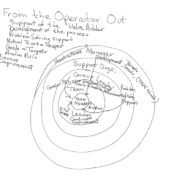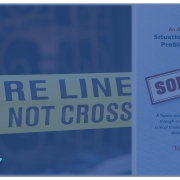The Role of HR in a Continuous Improvement Organization: The Rational Way Forward
(Reposted by permission of the author from LinkedIn)
In my work as a consultant, I have had the opportunity to work with many companies who ask for help with their HR Department. I have found many approaches taken by these organizations, but two stand out as being the most persistent. The first is a department that works to eliminate all risk from running a business. Everything is looked at through the lens of risk and employees are considered the most risky. The second is an HR department that loves to chase the latest thing. It is not that these are wrong endeavors. As part of a system, these approaches can contribute, but when they are exclusive they are at the expense of a rational way forward to an HR system.
What I mean by the rational way is that logic and facts are the drivers of intention, that precedence is not the only determinant to solutions and improving the system of production is the likely result. Fact finding is at the basis of becoming logical and rational. It assures that at the foundation of any decision are the facts and they are considered vital in defining any problem. The second piece at the base of the rational way is the defining standards or expectations which should be used as a basis of comparison. If you have these two pieces, then the problem is defined as a deviation from the standard or expectation. Once the deviation is found then problems are well on their way to being solved. If there is no standard, then one must be created before proceeding in a rational way.
Many organizations are not utilizing the standard as a component of problem definition because there is not one. What this allows is any person making a decision can bring into their thinking their own bias or align every decision to insure it is consistent with their experience. For an employee, this is not very comforting. Ironically, risk of a bad decision goes up when any decision maker comes to the conclusion without first understanding the problem. This practice is void of a request for facts in the current situation and leaves the reviewer to input their opinion without the benefit of facts and logic.
It is my belief that HR and Management in general has the responsibility of making sure the rules, policies and expectations are clearly known and understood. This leads to the utilization of facts as the way forward. Just having posted paper on a bulletin board does not ensure that all employees understand. The communication is not complete until both parties understand what is being said. The cycle of communication involves the sender and the receiver having acknowledged that they have been communicated with and the intent of the communications is understood. This is particularly important when most of the communications are pushed to the internet for convenience. Rational solutions are required to bridge this communication gap.
To understand the rational way, it is a requirement that all of management consistently work to understand how value is added. This is a subtle and powerful form of communications. Every day, it should be a requirement for all leaders to spend more time than they normally would just getting to know people and their issues. Simple things like being able to greet an employee by their name is important for building the rapport and alignment for meeting customer demand. HR should be a role model and coach to accomplish this. The leaders effort to represent the employees requires each employee be known and respected. At the center of this is respect for their work leading to a desire to help solve problems. As these interactions proceeds the leader will become more familiar with the issues and concerns of the workplace. Leader’s major contribution is to support the solving of problems as a development opportunity. HR’s responsibility is to ensure this process proceeds with mutual trust and respect.
Rational solutions require that the people who add value easily understand and implement the expectations. The reality is that this takes more time but is ultimately time well spent toward engaging the employee. For the employee, the development of their work standard delivers clear understanding of their accountability. Support of employees in solving problems in their standard creates a clear sign of valuing them. Asking for help by the leader is an indication of respect. I have found that this thinking also drives the value-adder to solve problems that are small in scope, easy & inexpensive to implement and meet much less resistance.
My view is that the rational way for HR is to facilitate the development of a basis of comparison in policy, goals and expectations that are clearly understood and acknowledged. The beginning of this is the creation of policies whose foundation is the success of the business and the employee. Policy is a tool, if used properly, can create an important basis of comparison. The act of creating policy requires a deep understanding of how work gets done and improved.
Policy needs to be written for the general audience of the company and written so anybody at any level can understand. There is a lot of research that employees are not always comfortable with representing themselves and will seek out third party relationships to represent them unless great care is taken to make sure that the policies are clear, understood and modeled by leadership. It is leadership’s responsibility to behave as a role model in a way that is clearly aligned to the policies and operating principles. It is clear the policy that creates this environment is a principal product of the HR organization. HR is creating culture in all aspects of the work life that is consistent with the success of the organization through success of the employee.
Leadership has the responsibility to not only represent the policies in their enactment but be a part of the more detailed explanations of what the intent and process is for implementing them. This usually is initiated during the on-boarding process but is reinforced in every interaction with the employee. For example, absenteeism is always a key issue. For the company it is key to having a predictable capacity for quality work. If this is believed and understood by all, then the issue with someone who is absent is not how that person will be punished but how they can problem solve absence by coming up with a valid solution. I have found that this issue is so important for the supervisors that when any employee is absent for the first time, a long discussion will ensue with the employee to reinforce how important it is to be at work. This is not as simple as a supervisor saying, “I need you here”, but a detailed discussion of the organization’s expectations, the requirements for production flow, the disruption that is caused when there is no casual pool of people to take the place of the absent person and how problem solving can get at the root cause of the absence. The intent of this discussion is to make sure the employee maintains accountability for being present by creating a solution of their own.
For all the leaders the conviction for managing comes from the expectation of the deployment of organizational goals called the Hoshin Kanri process. Hoshin Kanri is a process that starts at the very top of the organization where the strategy is set and turned into annual goals. These are the goals that need to be realized to accomplish the longer term strategic plan. Hoshin is a rationale problem solving process that focuses not just on deploying goals but aligning them to the strategy while gaining commitment from the employee. They are usually about 10 to 20% of the goal performers effort during the planning period. Simply stated, the process requires the superior leader to share their goals which are the “what needs to be done” with the subordinate who is asked to define in a plan, “how”, the goal will be accomplished. During this process, the leader must work with the subordinate to achieve a consensus commitment and accountability as a required gate to the process proceeding as intended. The subordinate, in turn, will repeat the exact process with their subordinates who will repeat the process until the entire organization is aligned. In the end, the “how’s” become an individual plan for both the subordinate and the leaders to review to ensure completion of tasks on-time and on-target. The process requires that organizational resources are identified and their support is attained. Problems in lack of attainment of goals are dealt with the same as any other problem.
HR’s role is vital and rational in Hoshin Kanri. For the process to work effectively, everyone must be able to communicate with confidence the intent of the goals with the expectation of the action to follow from the subordinate. Support for these goals is done through coaching and training. The HR department has the benefit of knowing the process expectations. They shape their coaching and training to ensure every leader is adept at conducting the planning and execution of the goals. During the course of the planning period, the HR representative will sit in on the planning sessions and the review process to make sure all members of the organization are accomplishing their intended purpose. The tools they use include the rational problem solving model where deviations from the plan are treated as problems to be solved. When a problem is encountered, facts are gathered prior to the reviews ensuring the discussion is based on facts. In these situations, it is often said, “thank you for your opinion but I would much rather deal with facts”. From HR’s perspective, discussions do not proceed without having gathered the facts. In the HR interaction, the key is to make sure the problem solving is rational and success is found as a way forward. In the end personal accountability must be preserved. There is no such thing as someone other than the employee solving their own problems.
If countermeasures to problems are agreed to, then the HR representative has the tools to monitor the behavior of the subordinate and the leader and give feedback on how to achieve the problem’s solution. The HR person would in turn brief the supervisor on the coaching with the intent of making the supervisor aware and responsible for future coaching and development. The perspective on all discussions is to maintain personal accountability of the employee with the leader providing support when issues arise.
For the employee, the system of Hoshin is an important element for success supported by having leadership ready to help if needed. The employee feels that their work is valued, they have control over their work and the organization is prepared to support when needed. The focus by leaders is always inward to the success of the value adder.
One great benefit of the rational way is the simplicity of the models. There is only one model in the Toyota world. The plan, do, check and adjust model is the same for planning, the role of the leader and for problem solving. As issues get more complex, it is clear that this simple model is all you need to proceed to higher performance. For leaders, this means that the endless chase for a new model is unnecessary and will avoid startup and confusion.
The supervisor knows well that their greatest accountability is to accomplish goals. The employee’s contribution is to follow the standard and take the initiative to achieve continuous improvement. All of this must be supported by the relationship created at the workplace. The supervisor is taught that the atmosphere should be warm, friendly and homelike. Everyone must be treated as adults. Interactions must lead to positive outcomes and to never take the accountability from the worker. These are also a priority for the support organizations. Support organizations must not come to the workplace with the answer but must always enable rational thinking from the employee by asking good questions. These questions are given to enable good complete systems thinking. This is the backbone of the culture which is the system of production .
As more data enters the workplace, it is vital for HR to reinforce the rational thinking role. Data gathering is an active part of the job while solutions must support the decision making without taking from the employee accountability for performance. Access to the appropriate data and it’s proper use will be a protective challenge by HR. We all know how data can be manipulated to arrive at the desired answer. Not only does HR need to ensure access is given to data but to make sure the data is not being misused or mis-interpreted. Data sources must be reliable and accurate, but it must never be used as an excuse to take away from the employee the ability to have control of their process. For the organization, the best way to consistent quality and productivity is to have an employee developed standard for every job and a standard that is proven to be valid,reliable and owned by the person creating it. For HR to be a representative, they must understand that standards are required for the reliable execution of work. The best way for HR to achieve this is to understand the development of the standard. The development of the standard is wholly the employee’s responsibility so auditing their process creates the best way forward for HR support. During this time of standard creation, the HR person monitors the team interaction with the supervisor and the support organizations like production engineering and quality to make sure all employees are treated as an adult, listened to and that they experience being treated with mutual trust and respect. All of this leads to the ownership of the standard by the employee.
HR representatives will also have their goals to accomplish along with the development of the individual and the environment of mutual trust and respect. This requires efficient and effective interaction with all they encounter. In most of these interactions, the employees are the leaders of the conversation and HR has the role by listening, understanding and determining how support needs to be accomplished. All ideas in the construction of the standard are set down by the employee’s observations and opinions must be understood and at least initially considered vital to the accomplishment of goals. HR must be seen as open, accepting and logical in their approach to garner the greatest amount of cooperation and accountability of all concerned. In the end, this interaction will determine the quality of the work of HR not as an individual but as a representative of the company as a whole. This deep engagement by HR sets the tone for their usefulness and accountability.
Questions to Consider:
- What are the behaviors required for good representation by HR?
- What should happen when the goals planned by the HR Representative do not have consensus?
- What is it about problem solving that makes it ideal for interactions?
- What should be the standard for metrics where value is added?
- How should planning be accomplished to represent good logical thinking?
- Who should create the standards for all value added work?
- How should support be accomplished?


 2019, Total Systems Development, Inc.
2019, Total Systems Development, Inc.
 Total Systems Development, Inc., 2019
Total Systems Development, Inc., 2019 2019, Total Systems Development, Inc.
2019, Total Systems Development, Inc. 2019, Total Systems Development
2019, Total Systems Development

 Total Systems Development, Inc., 2019
Total Systems Development, Inc., 2019